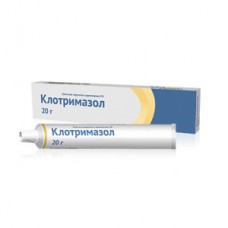Expiration date: 04/2026
Composition
100 g of cream contain active ingredient: Clotrimazole - 1.00 g
Pharmacotherapeutic group
Antifungal
pharmachologic effect
Clotrimazole inhibits the growth and division of microorganisms and may have a fungistatic (retarding and stopping the growth of fungi cells) or fungicidal (fungus leading to death) effect. Clotrimazole inhibits the synthesis of ergosterol and phospholipids bind to the cell membrane of the fungus, which leads to a change in cell membrane permeability.
Ultimately clotrimazole impact on fungal cells leads to their death.
The spectrum of activity
Clotrimazole is characterized by a broad spectrum of antifungal activity:
- dermatophytes (Epidermophyton floccosum, Microsporum canis, Trichophyton mentagrophytes, Trichophyton rubrum),
- yeast (Candida spp., Cryptococcus neoformans),
- dimorphic fungi (Coccidioides immitis, Histoplasma
- capsulatum, Paracoccidioides brasiliensis),
- protozoa (Trichomonas vaginalis).
It is also active against certain gram-positive bacteria, pathogen multi-colored lichen (Malassezia furfur) and the pathogen erythrasma.
Mushrooms that are resistant to clotrimazole, are extremely rare; there are data only for individual strains of Candida guilliermondii.
None reported about the development of resistance in fungi sensitive to clotrimazole after the passage of Candida albicans and Trichophyton mentagrophytes. No cases of resistance to clotrimazole C. albicans strains, resistant to polyene antibiotics by chemical mutation.
Indications
For topical treatment of fungal diseases of the skin caused by dermatophytes, yeast fungi, molds and pathogens sensitive to clotrimazole: tinea pedis, hands, body, skin folds; candida vulvitis, candida balanitis; pityriasis versicolor, erythrasma; fungal infections of the outer ear.
Contraindications
Hypersensitivity to clotrimazole or any other components of the preparation.
I trimester of pregnancy.
Dosing and Administration
For external use only. The cream should be applied a thin layer to the affected skin 2-3 times a day.
The cream should be applied to clean, dry skin areas affected (washed with soap with a neutral pH), at the foot cream should be applied between the toes.
The duration of treatment depends on the severity of the disease, its location, the effectiveness of treatment.
Duration of treatment:
- ringworm - for 3-4 weeks;
- erythrasma - 2-4 weeks;
- chromophytosis - 1-3 weeks;
- Candida vulvitis and balanitis - 1 -2 weeks.
To prevent a recurrence, treatment should continue for at least two weeks after the disappearance of all the symptoms of infection.
If, after 7 days of treatment no improvement of symptoms, you should consult with your doctor.
Special patient groups
There are no data on dose adjustment for children, elderly patients, patients with impaired renal function and liver.


